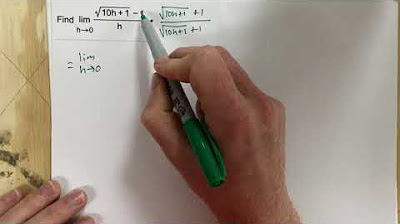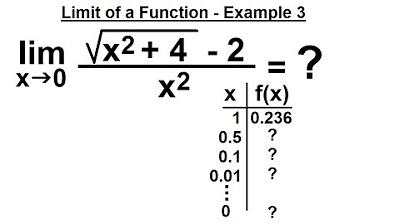Example (2.2) - Finding the limit of a function #8 (Calc)
TLDRIn this educational video, the instructor explores the concept of finding limits in calculus, specifically focusing on a function that becomes undefined as 'H' approaches zero. The video demonstrates a common issue where direct substitution results in division by zero, indicating a discontinuity at the point of interest. To resolve this, the instructor uses algebraic manipulation, including rationalizing the numerator, to transform the function into a form that allows for the evaluation of the limit as 'H' approaches zero. Through this process, the function simplifies to a form that yields a clear result, illustrating the importance of algebraic techniques in calculus when direct substitution is not feasible.
Takeaways
- 📚 The video is an educational tutorial focusing on finding limits in calculus, specifically as a variable approaches zero.
- 🚫 Directly plugging in zero into the given function results in an undefined expression, indicating the function is not continuous at zero.
- 🔍 The issue arises from an attempt to divide by zero, which is mathematically undefined.
- 🛑 The function has a 'disconnect' at x = 0, meaning it is not defined at that point, and thus the limit cannot be evaluated by direct substitution.
- 🤔 The presenter suggests an algebraic approach to resolve the undefined issue and find the limit.
- 🔄 The thought process involves canceling out the variable H to avoid division by zero.
- 📝 Rationalizing the numerator by multiplying the expression by its conjugate is a technique used to simplify the function.
- 📈 After rationalization, the function is manipulated algebraically to cancel terms and simplify the expression.
- 🔄 The presenter factors out an H and cancels terms to simplify the expression further.
- 🎯 The simplified form of the function allows for the evaluation of the limit as H approaches zero without encountering division by zero.
- 🏁 The final result of the limit as H approaches zero for the given function is 7, achieved through algebraic manipulation and understanding of limit properties.
Q & A
What is the main topic of the video script?
-The main topic of the video script is finding the limit of a function as H approaches zero, specifically addressing a scenario where direct substitution results in an undefined expression.
Why is direct substitution of zero into the function problematic in this case?
-Direct substitution of zero into the function results in division by zero, which is undefined, indicating that the function is not continuous at the point zero.
What does it mean for a function to be undefined at a certain point?
-A function being undefined at a certain point means that there is no value assigned to that point in the function's domain, and it does not have a corresponding point on the graph.
What algebraic approach does the script suggest to resolve the issue with the undefined expression?
-The script suggests rationalizing the numerator and then simplifying the expression to cancel out the variable H, which allows for the evaluation of the limit without direct substitution.
What is the purpose of rationalizing the numerator in this context?
-Rationalizing the numerator helps to eliminate the square root in the denominator, which is necessary for simplifying the expression and canceling out the variable H.
How does the process of multiplying the numerator and denominator by the conjugate help in simplifying the expression?
-Multiplying by the conjugate eliminates the square root in the denominator and allows for the cancellation of terms, simplifying the expression to a form that can be evaluated as H approaches zero.
What is the final simplified form of the function after the algebraic manipulations?
-The final simplified form of the function is 14 over the square root of 14H plus 1 plus 1, which simplifies further to 14 over 2 as H approaches zero.
What is the limit of the function as H approaches zero according to the script?
-The limit of the function as H approaches zero is 7, which is obtained after simplifying the expression and evaluating it at H equals zero.
Why is it important to evaluate the limit in a different form when direct substitution fails?
-Evaluating the limit in a different form is important because it allows us to find the behavior of the function as it approaches a certain value, even when direct substitution results in an undefined expression.
What does the script imply about the relationship between the limit of a function and its continuity at a point?
-The script implies that if a function is undefined at a point, it is not continuous at that point, but this does not necessarily prevent us from finding the limit of the function as it approaches that point.
Outlines
📚 Understanding Limits with Algebraic Manipulation
This paragraph discusses the process of finding the limit of a function as H approaches zero. Initially, the function appears to be undefined at zero due to division by zero. The speaker explains that the function is not continuous at zero, indicating a disconnect in the graph. To address this, an algebraic manipulation is performed to eliminate the square root and cancel out the H variable. The process involves rationalizing the numerator, multiplying by a conjugate, and simplifying the expression. The goal is to transform the function into a form where the limit can be evaluated as H approaches zero without encountering undefined expressions.
🔍 Evaluating the Limit After Algebraic Manipulation
Following the algebraic manipulation from the previous paragraph, the speaker continues by simplifying the function further. The process includes factoring out H and canceling terms to reach a simplified form of the function. The new form allows for the evaluation of the limit as H approaches zero without any undefined operations. The final step is to substitute H with zero in the simplified expression, which leads to the conclusion that the limit of the function as H approaches zero is 7. This demonstrates the importance of algebraic manipulation in evaluating limits when direct substitution results in an undefined expression.
Mindmap
Keywords
💡Limit
💡Undefined
💡Continuous
💡Algebraic Manipulation
💡Rationalize
💡Numerator
💡Denominator
💡Factor Out
💡Cancel
💡Foil Method
💡Square Root
Highlights
Introduction to finding limits in section 2.2.
Attempt to find the limit of a function as H approaches zero.
Observation of an undefined result when plugging in zero due to division by zero.
Explanation of the function being undefined at zero, indicating discontinuity.
Illustration of a potential function graph with a disconnect at x=0.
Introduction to algebraic manipulation to evaluate the limit when direct substitution is not possible.
Strategy to cancel out the H in the function for easier manipulation.
Rationalization of the numerator to facilitate the cancellation of the square root.
Multiplication of terms to eliminate the square root and simplify the expression.
Cancellation of terms to simplify the function further.
Factoring out an H to prepare for the limit evaluation as H approaches zero.
Simplification of the expression to isolate the term involving H.
Final simplification leading to a form where the limit can be evaluated by plugging in zero.
Evaluation of the limit as H approaches zero, resulting in the function approaching 7.
Conclusion on the process of algebraically rearranging the function to find the limit.
Emphasis on the importance of algebraic manipulation when direct substitution leads to undefined results.
Transcripts
Browse More Related Video

Example (2.2) - Finding the limit of a function #10 (Calc)

2.2 - Problem #4 (Calc)

Trig limit using pythagorean identity | Limits and continuity | AP Calculus AB | Khan Academy

Calculus 1: Limits & Derivatives (6 of 27) Finding the Limit of a Function - Example 1

Calculus 1: Limits & Derivatives (8 of 27) Finding the Limit of a Function - Example 3

Applying the Definition of the Derivative to 1/x
5.0 / 5 (0 votes)
Thanks for rating: